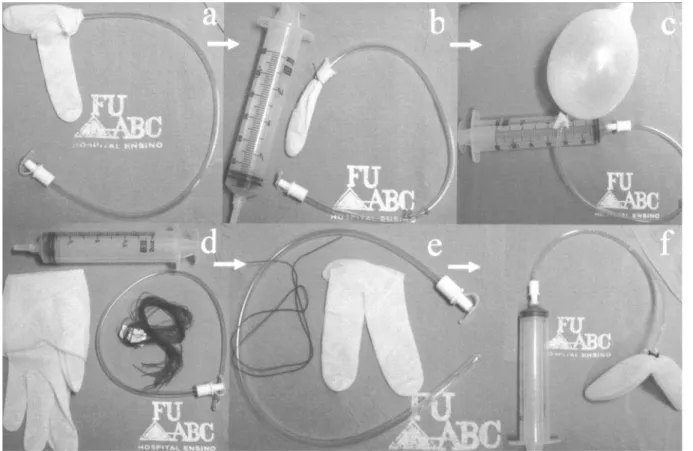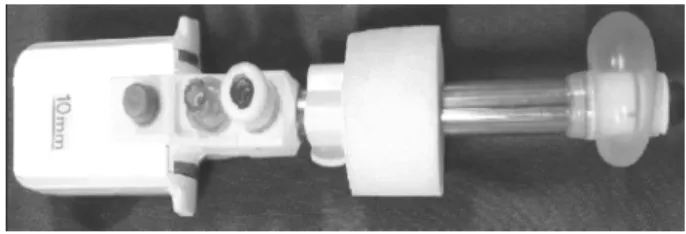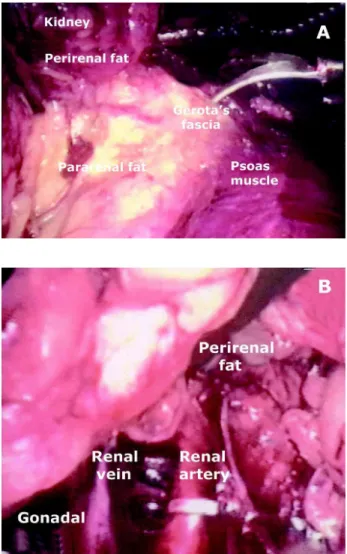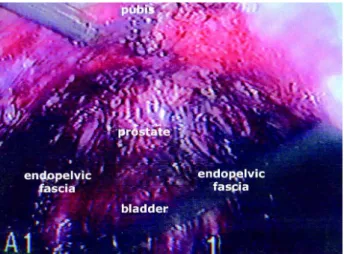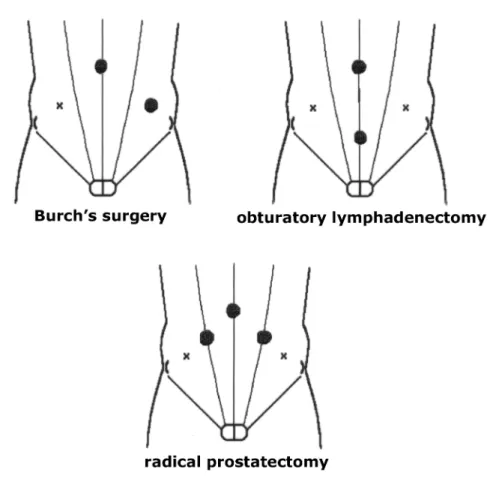VIDEOENDOSCOPIC SURGERY BY EXTRAPERITONEAL ACCESS:
TECHNICAL ASPECTS AND INDICATION
M. TOBIAS-MACHADO, ROBERTO V. JULIANO, HELOISA A. GASPAR, RICARDO P.
ROCHA, MILTON BORRELLI, ERIC R. WROCLAWSKI
Discipline of Urology, ABC School of Medicine (FMABC), Santo André, São Paulo, Brazil
ABSTRACT
Laparoscopic surgery in urology is definitely incorporated to the techniques of minimally invasive treatment for urogenital diseases. Though the classic access to organs in the urinary tract is extraperitoneal, this access has not been prioritized when the videoendoscopic technique is used. In Brazil, few groups use this approach and little has been discussed about its true practical applicability. The authors intended to discuss the main technical aspects and criteria for indication, re-ported though the improvement achieved in a 5-year period with 150 operated cases.
A review of the literature shows that the worldly acceptance of the extraperitoneal endo-scopic approach is increasing. Nevertheless, there are no evidences that the extraperitoneal access is superior to the transperitoneal route. Thus, the choice depends basically on the surgeon’s preference. Major advantages are the immediate access to the renal hilum and isolation of peritoneal structures. Employing this access is useful when one suspects that significant peritoneal adherences could pre-vent the surgical act or when one wishes to preserve the integrity of the peritoneal cavity.
Key words: video-assisted surgery; laparoscopic surgery; retroperitoneal space Int Braz J Urol. 2003; 29: 441-9
INTRODUCTION
Ablative laparoscopic surgery in urology is widely accepted in selected situations because it pre-sents well defined advantages in relation to open sur-gery, such as earlier return to routine activities, re-duction in the hospitalization, decreased blood loss and reduction in analgesic use post-operatively, in addition to superior esthetic result (1,2).
Extraperitoneal access is the preferential route in cases of open urologic surgery because it provides a direct approach to the organs of the uri-nary system, without the need of manipulating the bowel, with a lower possibility of paralytic ileus and with drainage of the open urinary tract without con-tact with the peritoneal cavity. Despite these features, few specialized centers have prioritized the
retroperi-toneal approach when videoendoscopic access is employed.
Figure 1 – Positioning of surgical staff in lumbar access.
Figure 2 – Positioning of surgical staff in pelvic access.
we have used, preferably, this access, since 1997, in the treatment of several urologic diseases (3).
We intended to describe the technical aspects and main advantages and disadvantages of this mini-mally invasive access, comparing them to data in the literature.
SURGICAL TECHNIQUE AND
STRATEGY
General
Checking of Material – The material required for surgery is the same used for conventional laparoscopic surgery, added by some details that are inherent to each particular surgical procedure.
Disposition in the Surgical Room – In lum-bar access, the surgeon operates the patient in a posi-tion similar to open surgery, that is, posterior. Due to the lateral position of the patient in the surgical table and the long length of the laparoscopic material, we recommend that the surgeon, for better comfort, be positioned over an estrade. The camera stands beside the surgeon with the assistant and the instrumental table, at the contralateral side (Figure-1).
The positioning of the surgical team for pel-vic surgery is the same described for transperitoneal laparoscopic surgery (Figure-2).
Lumbar Surgery
Position of the Patient – The patient is placed in lateral decubitus, opposed to the side intended for surgery, the table is flexed in order to raise the flank area and to enlarge the space between the iliac crest and the costal border. The patient is fixed in this po-sition and the extremities are arranged in order to avoid or minimize neuromuscular sequelae.
Access to the Retroperitoneum - The retro-peritoneal cavity must to be created in order to posi-tion the trocars and develop the surgical procedure. Initially a transverse incision is performed by 1.5 cm planes, below the extremity of the 12th rib the
thoracolumbalis fascia is opened, reaching the
retro-peritoneal space. A careful digital dissection is per-formed in the anterior, postero-superior and inferior directions, promoting the separation between the psoas muscle posteriorly and the Gerota’s fascia an-teriorly (9). It is important to ensure that all entrance ports are largely free of adherences, so that punctures can be performed under direct viewing, without le-sion of adjacent organs.
Figure 3 – Homemade dilating balloon with single (a,b,c) and double (d,e,f) glove finger.
We have used a balloon made through a double glove finger (placing one finger inside the other so to ob-tain greater resistance against rupture), tied with a cotton thread to a 18F urethral catheter, where we inject physiologic saline solution. This device allows a 500 - 1000 mL capacity, depending on the proce-dure to be performed (Figure-3). In proceproce-dures where we intend to approach the middle/distal ureter (espe-cially nephroureterectomies), we use the 2 balloons technique previously described by Gill et al. (13).
Initially, as preconized by Gaur, we left the balloon inflated for 10 minutes, with the objective of performing the hemostasis of small vessels. Based on the experience of certain groups that perform only the digital technique, we started to remove the bal-loon immediately after its expansion and we did not observe bleeding or any difference in the quality of the images obtained.
Figure 4 A) – Open access to retroperitoneum under direct viewing; B) – Threaded device to avoid escape of gas; C) – Fixing mechanism of the classic Hasson trocar through 2 wires attached to the aponeurosis.
Figure 5 – Trocar with internal balloon and sponge that enables an excellent sealing of gas.
which are places located deeper and with difficult access under linear viewing.
Secondary Ports – All of them are introduced under direct viewing with the aid of optics. The sec-ond port (10 mm) is positioned 2 cm above the iliac crest, through the floor of the inferior lumbar triangle (Petit). Some authors prefer to start the retroperito-neal access at this point. Next, the optics is trans-ferred to this port. The third port (5 mm) is placed 1.5 cm inferior and lateral to the angle formed be-tween the lower edge of the 12th rib and the
paraver-tebral muscles, making sure that it penetrates above the subcostal nerve. This port and the access port are used by the surgeon. The fourth port (5 mm) is ma-nipulated by the assistant in order to separate the struc-tures and must be introduced below the extremity of the 11th rib or in medial position in the anterior
axil-lary line so that it does nor perforate the peritoneum (Figure-7) (14).
Slight variations are required according to the procedure. For adrenal surgery, punctures are made
at a 1-2 cm more anterior position, to make the ac-cess to the gland easier, especially the most posterior trocar, which could present difficulty during the ap-proach in a conventional position due to the distance and the limitation in the forceps length.
The same access is useful when one intends to perform sutures, allowing a better approach angle to the renal pelvis (pyeloplasty and pyelolithotomy). In such cases a slight lateral decubitus to the surgeon side is necessary in order to promote better comfort. Still on access variations, it can be useful to replace the assistant’s 5 mm trocar by a 10 mm trocar in cases there it is necessary to separate more widely the peritoneum (giving access to a liver retractor), such as in adrenal surgeries or when a peritoneal per-foration occurs, rendering the procedure difficult.
When the surgeon intends to perform a nephroureterectomy, the port of the Petit’s triangle is placed in a more anterior position, so that it enables a better distal view of the ureter, and the surgeon can perform urethral dissection moving to the other side and using a more medial and more inferior puncture, with the optics being transferred to superior median puncture. In this situation, the change in the spatial orientation requires the monitor to be transferred to the patient’s lower region.
Pelvic Surgery
Position of the Patient – The patient is placed in semi-gynecologic position with a Foley’s catheter draining the bladder. We prefer using a wooden plate
Figure 6 – Anatomic repairs in lumbar access (endoscopic view).
A) – Visualization of muscles posteriorly and Gerota’s fascia anteriorly. B) – The access to the renal hilum is immediate.
Figure 7 – Positioning of the ports for surgery in the lumbar region (patient in left lateral decubitus). = 5 mm port; = 10 mm port.
in the shape of an inverted “Y”, but it is possible to adapt the position in a table with stirrups. When the approach over the bladder or the urethra is nor neces-sary (lymphadenectomy), the patient can be placed in supine position.
Approach to the Pre-Peritoneal Region – A 1.5 cm arcuate incision in the umbilicus or a vertical intra-umbilical incision is made. The dissection is performed in the subcutaneous tissue and the apo-neurosis, promoting its transverse opening, close to the linea alba. It is possible to view the Douglas’
ar-cuate line posteriorly and the borders of the abdomi-nal rectus muscle laterally. The medial region of the abdominal rectus muscle is digitally dissected towards the Retzius’ space and until the pubic symphysis, moving the peritoneum posteriorly.
Similar to the lumbar access, all the potential entrance sites for the trocar must be released from the peritoneum, in order to avoid its perforation. Sites that are more difficult to dissect are the lateral re-gions of hypogastrium (lateral insertion of the Dou-glas’ ligament). Differently from the transperitoneal access, a largely exaggerated Trendelemburg position is not necessary, since the intact peritoneum provides support to the bowel, a fact that can promote anes-thetic advantages resulting from a smaller cephalic slope.
Figure 8 – Anatomic repairs in pelvic access (endoscopic view). Visualization of bladder, prostate and pubic bone.
Creation of Pneumoretroperitoneum – Per-formed similarly to the lumbar access. Upon verify-ing the created space, it is possible to view the blad-der, the pubic symphysis and eventually the iliac ves-sels (Figure-8).
Secondary Ports – The number and position of ports depend on the surgical procedure to be per-formed (Figure-9). A 10 mm trocar positioned on the median line 2 cm above the pubic symphysis can be used for the surgeon’s work, jointly with a forceps that is introduced in the 5 mm trocar, 2 cm superior and medial to the antero-superior iliac spine, oppo-site to the side that will be approached. We prefer this conformation for pelvic lymphadenectomy. Some procedures can be performed with only 3 ports (2 in iliac fossae for the surgeon), as in Burch’s surgery.
Complex procedures such as radical prostate-ctomy require 5 ports, 2 of them placed between the optics and the punctures in iliac fossa (suited for dis-section and sutures).
COMMENTS
Extraperitoneal access represents the prefer-ential approach in conventional urologic surgeries (13,15,16). However, the initial application of extraperitoneal videoendoscopic surgery presents
greater technical difficulty, mainly due to a smaller working space, lower lightning and the spatial orien-tation, which are responsible for a larger learning curve (6-8). The issue of working space is relative and directly associated with a good peritoneal detach-ment and proper installation of the ports, being fea-sible even in children (17,18). Concerning the spatial orientation, the optics must be always kept in a posi-tion where it is possible to observe the posterior muscles in horizontal position, thus allowing anatomi-cal parameters to be identified. In our Service, where 150 retroperitoneoscopic procedures were performed up to now, we did not observe a greater difference in the technical adaptation for this approach, when com-pared with the transperitoneal route.
We believe that the expansion of the extraperitoneal space with the aid of the atraumatic balloon – either hand-made, industrialized, direct viewing-guided or not – is recommendable since it enlarges the surgical field in areas that cannot be reached by the finger, reducing the need of forceps dissection (3,14,17). The use of the balloon trocar has the advantage of allowing the visualization of structures, especially the renal pedicle, during the expansion. Most authors do not believe that the loca-tion of the dilating balloon inside Gerota’s fascia is essential, as it was originally described by Gaur (5). The creation of the pneumoretroperitoneum is similar to the one performed in the transperitoneal access, including the recommended pressure of 15 mmHg. There is controversy about the repercussions caused by the pneumoretroperitoneum when com-pared with pneumoperitoneum. Some works initially proposed the occurrence of a higher absorption of CO2 in pneumoretroperitoneum. Currently, it is believed that hypercapnia produced by CO2 insufflation does not differ between transperitoneal and retroperitoneal accesses, with rates around 5-10%, and rarely with the appearance of clinical manifestations (8,19).
sub-Figure 9 – Positioning of the ports in the pelvic region according to the procedure. = 10 mm port; x = 5 mm port.
mitted to extraperitoneal laparoscopy (19). Gill et al. observed the occurrence of pneumothorax and pneu-momediastinum in 0.6% and 0.4%, respectively. Nev-ertheless, they stress that the post-operative radiologi-cal control was not routinely performed in all patients, and those values could be underestimated due to un-diagnosed subclinical cases (8).
The permanent surgical material used in retroperitoneoscopy is similar to that used in conven-tional laparoscopy, except for the Hasson trocar, which eventually can be replaced by a common 10 mm trocar fixed to the aponeurosis by a “purse-string” suture.
Excess or improper location of trocars can promote a collision between the forceps, a fact known as “trocars conflict”, responsible also for a greater difficulty in suture. Due to these issues, few series
report reconstructive procedures through extraperitoneal access (3,7,20).
Inadvertent peritoneal opening, with resulting pneumoperitoneum, can increase the grade of techni-cal difficulty. It is more pronounced during pelvic sur-geries, since in lumbar surgeries the lateral position displaces the bowel medially (8). When it is not pos-sible to proceed with the surgery, a transperitoneal puncture can be made for escape of air, as well as the conversion to transperitoneal laparoscopic technique or, as the last option, conversion to open technique.
maneuver easier (6).We have not used this maneuver routinely, since it is usually possible to handle the speci-men in the retroperitoneal space. When the specispeci-men is too large and requires the enlargement of one of the ports, we enlarge the incision and introduce the bag in the retroperitoneum under viewing, favoring the intro-duction of the specimen in the surgical bag as well.
There are some factors that can hamper or prevent the use of extraperitoneal access. The pres-ence of obesity, which results in a higher amount of retroperitoneal fat, is a factor of increasing difficulty for identifying structures of the renal pedicle and ad-renal gland. Despite the surgical time getting longer and the surgery being a lot more laborious, the ben-efits for this group of patients are indisputable.
Conditions where there is no capacity for cre-ating a space between the kidney and the abdominal musculature, such as previous retroperitoneal surgery, severe renal inflammation and the presence of very large kidneys, are relative contra-indications. In such situations it is possible to try to create the space and, in case of impossibility, the access port is used as an adjunct in the transperitoneal approach. We must also remind that in such cases, surgical difficulties will be found in the transperitoneal access as well, however with a larger space for work. Hemal et al. (12) re-ported the use of laparoscopic nephrectomy in 18 patients with large hydronephrosis (over 1,000 mL in volume, which surpassed the middle line or ex-tended themselves by more than five vertebral spaces), being 12 by retroperitoneal route. Hobart et al. also presented their favorable experience with bilateral extraperitoneal nephrectomy for polycystic kidneys (21). Contrary to most laparoscopists, both works preconize the extraperitoneal access as a choice in the management of kidneys with large dimensions. Hemal et al. showed also a large experience in the treatment of renal inflammatory pathologies (includ-ing pyonephrosis and tuberculosis), demonstrat(includ-ing that it is possible to use the extraperitoneal approach even when local inflammation is predicted (11).
CONCLUSION
The choice of access is fundamentally based in the surgeon’s preference and in particularities in each
case. The assumed difficulties that occur with the extraperitoneal access can be resolved if a rigorous technical standardization is achieved. Considering the advantages and limitations previously discussed, we use the extraperitoneal approach as the choice access in the majority of laparoscopic procedures in urology. We believe that even for surgeons who prefer the transperitoneal access, knowing the extraperitoneal access is useful, since it can be needed in patients with antecedents of major abdominal surgery or previous peritonitis, situations where intraperitoneal adhesions can hinder the transperitoneal surgery.
REFERENCES
1. Abbou CC, Cicco A, Gaswan D: Retroperitoneal laparoscopic versus open radical nephrectomy. J Urol.1999; 161: 1776-80.
2. Winfield HN, Hamilton BD, Bravo EL, Novick AC: Laparoscopic adrenalectomy: the preferred choice? A comparison to open adrenalectomy. J Urol. 1998; 160: 325-9.
3. Tobias-Machado M, Pinto MA, Juliano RV, Borrelli M, Wroclawski ER: Extraperitoneal laparoscopic ac-cess: experience in 72 cases. Int Braz J Urol. 2001; 27 (suppl 2): 121-122 [in Portuguese].
4. Wichkam JEA: The Surgical Treatment of Renal Lithi-asis. In: Wickham JEA, (ed.), Urinary Calculous Dis-ease. New York, Churchill Livingstone. 1979; pp. 145-198.
5. Gaur DD: Laparoscopic operative retroperitoneoscopy: use of a new device. J Urol. 1992; 148: 1137-9. 6. Gill IS, Schweizer D, Hobart MG, Sung GT, Klein EA,
Novick AC: Retroperitoneal laparoscopic radical ne-phrectomy: the Cleveland Clinic experience. J Urol. 2000; 163: 1665-70.
7. Gill IS, Rassweiler JJ: Retroperitoneoscopic renal sur-gery: our approach. Urology. 1999; 54: 734-8. 8. Gill IS, Clayman RV, Albala DM, Aso Y, Chiu AW,
Das S, et al.: Retroperitoneal and pelvic extraperitoneal laparoscopy: an international perspective. Urology. 1998; 52: 566-71.
9. Tobias-Machado M, Pinto MA, Juliano RV, Cintra CC, Wroclawski ER: Retroperitoneoscopic renal biopsy. Int Braz J Urol. 2002; 28: 192-6.
nephro-ureterectomy for benign nonfunctioning kidneys: a single-center experience. Urology. 2001; 57: 644-9. 12. Hemal AK, Wadhwa SN, Kumar M, Gupta NP:
Transperitoneal and retroperitoneal laparoscopic ne-phrectomy for giant hydronephrosis. J Urol. 1999; 162: 35-9.
13. Gill IS, Munch LC, Lucas BA: Initial experience with retroperitoneoscopic nephroureterctomy: use of a double-ballon technique. Urology. 1995; 46: 747-50. 14. Tobias-Machado M, Pinto MA, Juliano RV, Mattos MHE, Wroclawski ER: Alternatives for distal ureter resection in laparoscopic nephroureterectomy. Int Braz J Urol. 2002; 28: 109-15.
15. Gill IS, Grune MT, Munch LC: Access technique for retroperitoneoscopy. J Urol. 1996; 156: 1120-4. 16. Tobias-Machado M, Pinto MA, Juliano RV, Borrelli
M, Wroclawski ER: Preliminary results of ureteral intussuception in exclusive retroperitoneoscopic nephroureterectomy. Acta Esp Urol. 2002; 55: 582-6.
17. Tobias-Machado M, Cartum J, Santos-Machado TM, Gaspar HA, Simões AS, Cruz R: Retroperitoneoscopic adrenalectomy in an infant with adrenocortical viriliz-ing tumor. São Paulo Med J. 2002; 120: 87-9. 18. Matin SF, Gill IS: Laparoscopic radical nephrectomy:
retroperitoneal versus transperitoneal approach. Curr Urol Rep. 2002; 3: 164-71.
19. Wolf JS Jr, Monk TG, McDougall EM, McClennan BL, Clayman RV: The extraperitoneal approach and subcutaneous emphysema are associated with greater absorption of carbon dioxide during laparoscopic re-nal surgery. J Urol. 1995; 154: 959-63.
20. Janetsckek G, Peschel R, Franscher F: Laparoscopic pyeloplasty. Urol Clin North Am. 2000; 27: 695-704.
21. Hobart MG, Schweizer D, Gill IS: Bilateral retroperitoneal laparoscopic nephrectomy for adult polycistic kidney disease. J Endourol. 1999; 13 (suppl 1): 90-1.
Correspondence address: Dr. Marcos Tobias-Machado Rua Oscar Freire, 1546 / 53 São Paulo, SP, 05409-010, Brazil Fax: + 55 11 3887-3363
E-mail: telmamsm@icrhcnet.usp.br

